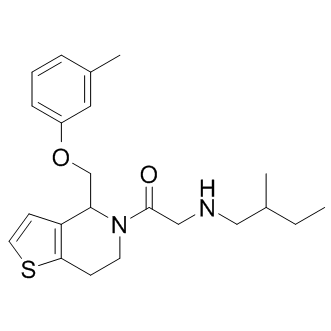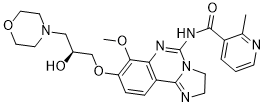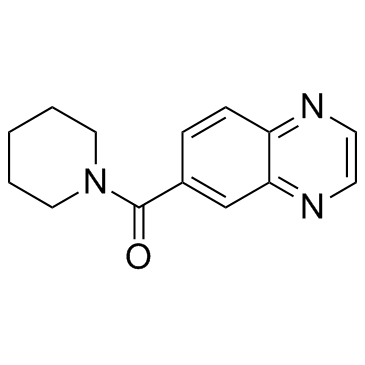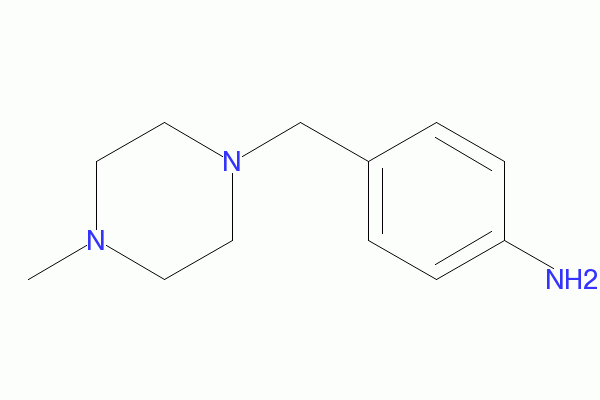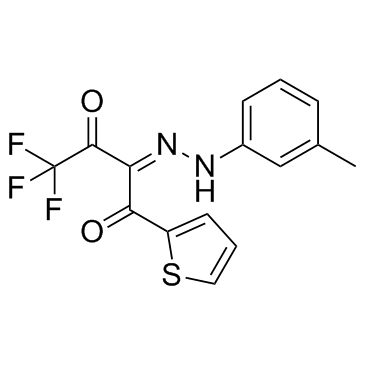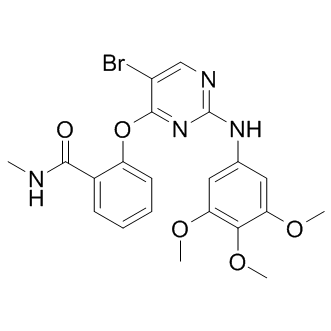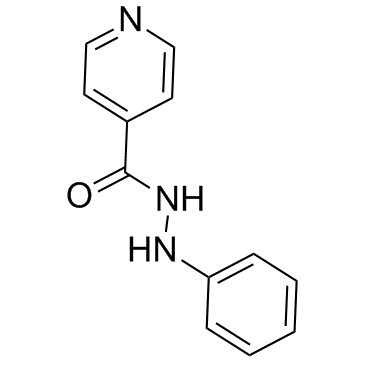Luliconazole(NND 502) is an azole antifungal indicated for the topical treatment of interdigital tinea pedis.
IC50 Value:
Target: Antifungal
Luliconazole is an antifungal that belongs to the azole class. Although the exact mechanism of action against dermatophytes is unknown, luliconazole appears to inhibit ergosterol synthesis by inhibiting the enzyme lanosterol demethylase. Inhibition of this enzyme’s activity by azoles results in decreased amounts of ergosterol, a constituent of fungal cell membranes, and a corresponding accumulation of lanosterol.
In a fertility study in rats, subcutaneous doses of 1, 5 and 25 mg/kg/day luliconazole were administered prior to and during mating and through early pregnancy. Treatment related effects on reproductive function were noted in females (decreased live embryos and decreased corpus luteum) at 5 and 25 mg/kg/day and males (decreased sperm counts) at 25 mg/kg/day. No treatment related effects on fertility or reproductive function were noted at 1 mg/kg/day (0.1X MRHD based on BSA comparisons).
[1]. In vitro antifungal activities of luliconazole, a new topical imidazole By Koga, Hiroyasu; Nanjoh, Yasuko; Makimura, Koichi; Tsuboi, Ryoji From Medical Mycology (2009), 47(6), 640-647.
Abstract
Luliconazole is a topical antifungal drug newly developed in Japan. The present study compares the in vitro antifungal activity of luliconazole against clinically important dermatomycotic fungi with that of other representative antifungal drugs. The reference drugs chosen were five classes of nine topical agents, i.e., allylamine (terbinafine), thiocarbamate (liranaftate), benzylamine (butenafine), morpholine (amorolfine), and azole (ketoconazole, clotrimazole, neticonazole, miconazole and bifonazole). The minimum inhibitory concentrations (MIC) of luliconazole and the reference drugs against Trichophyton spp. (T. rubrum, T. mentagrophytes and T. tonsurans) and Candida albicans were measured by the standardized broth microdilution method. Luliconazole demonstrated greater potency against Trichophyton spp. (MIC range: ≤0.00012-0.002 μg/ml) than the reference drugs, with T. rubrum being the most susceptible to it. ...
[2]. Koga H, Nanjoh Y, Kaneda H, Yamaguchi H, Tsuboi R. Short-term therapy with luliconazole, a novel topical antifungal imidazole, in guinea pig models of tinea corporis and tinea pedis. Antimicrob Agents Chemother. 2012 Jun;56(6):3138-43.
Abstract
Luliconazole is a novel topical antifungal imidazole with broad-spectrum and potent antifungal activity. The drug is under clinical development in the United States for management of dermatophytosis with a short-term treatment regimen. The present study was undertaken to investigate the clinical benefit of short-term therapy with luliconazole cream in guinea pig models of tinea corporis and tinea pedis induced with Trichophyton mentagrophytes. The dose-dependent therapeutic efficacy of topical luliconazole cream (0.02 to 1%), measured by macroscopic improvement of skin lesions and by fungal eradication as determined by a culture assay, was demonstrated using a tinea corporis model. The improvement in skin lesions seen with luliconazole cream was observed even at a concentration of 0.02%, and its efficacy at 0.1% was equal to that of 1% bifonazole cream. The efficacy of short-term therapy with 1% luliconazole cream, which is used for clinical management, was investigated using the tinea corporis model (4- and 8-day treatment regimens) and the tinea pedis model (7- and 14-day treatment regimens). The 1% luliconazole cream completely eradicated the fungus in half or less of the treatment time required for 1% terbinafine cream and 1% bifonazole cream, as determined by a culture assay for both models. These results clearly indicate that 1% luliconazole cream is sufficiently potent for short-term treatment for dermatophytosis compared to existing drugs. Luliconazole is expected to be useful in the clinical management of dermatophytosis.
[3]. Ghannoum MA, Long L, Kim HG, Cirino AJ, Miller AR, Mallefet P. Efficacy of terbinafine compared to lanoconazole and luliconazole in the topical treatment of dermatophytosis in a guinea pig model. Med Mycol. 2010 May;48(3):491-7.
Abstract
The in vivo efficacy of terbinafine was compared to lanoconazole and luliconazole in the topical treatment of dermatophytosis caused by Trichophyton mentagrophytes using a guinea pig model. Topical antifungal treatment commenced three days post-infection, and each agent was applied once daily for seven consecutive days. Upon completion of the treatment period, evaluations of clinical and mycological efficacies were performed, as was scanning electron microscopy (SEM) analyses. Data showed that while all tested antifungals demonstrated significant mycological efficacy in terms of eradicating the fungi over untreated control, terbinafine and luliconazole showed superior clinical efficacy compared to lanoconazole (P-values < 0.001 & 0.003, respectively). Terbinafine demonstrated the highest clinical percent efficacy. SEM analysis revealed hairs from terbinafine and lanoconazole-treated animals had near complete clearance of fungi, while samples from luliconazole-treated animals were covered with debris and few conidia. This study demonstrates that, in general, terbinafine possessed similar efficacy to lanoconazole and luliconazole in the treatment of dermatophytosis. Terbinafine tended to have superior clinical efficacy compared to the azoles tested, although this difference was not statistically significant against luliconazole. This apparent superiority may be due to the fungicidal activity of terbinafine compared to the fungistatic effect of the other two drugs.
[4]. Koga H, Nanjoh Y, Makimura K, Tsuboi R. In vitro antifungal activities of luliconazole, a new topical imidazole. Med Mycol. 2009;47(6):640-7.
Abstract
Luliconazole is a topical antifungal drug newly developed in Japan. The present study compares the in vitro antifungal activity of luliconazole against clinically important dermatomycotic fungi with that of other representative antifungal drugs. The reference drugs chosen were five classes of nine topical agents, i.e., allylamine (terbinafine), thiocarbamate (liranaftate), benzylamine (butenafine), morpholine (amorolfine), and azole (ketoconazole, clotrimazole, neticonazole, miconazole and bifonazole). The minimum inhibitory concentrations (MIC) of luliconazole and the reference drugs against Trichophyton spp. (T. rubrum, T. mentagrophytes and T. tonsurans) and Candida albicans were measured by the standardized broth microdilution method. Luliconazole demonstrated greater potency against Trichophyton spp. (MIC range:
[5]. Tanaka T, Satoh T, Yokozeki H. Allergic contact dermatitis from luliconazole: implication of the dithioacetal structure. Acta Derm Venereol. 2007;87(3):271-2.







 Antibody-drug Conjugate/ADC Related
Antibody-drug Conjugate/ADC Related






